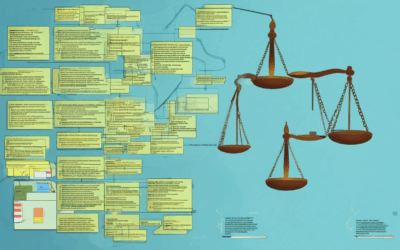When donors contribute to your cause, they expect to see the tangible results of their generosity. However, crafting an impact report that effectively communicates these outcomes can be challenging for nonprofits. This guide offers a comprehensive approach to creating a meaningful impact report tailored for donors, ensuring transparency and gratitude while highlighting the measurable differences their contributions have made. By aligning with donor expectations and providing clear, actionable insights, your organization can strengthen relationships and foster long-term support. Whether you’re new to impact reporting or looking to refine your existing efforts, this guide will walk you through the essential steps and provide a customizable template to streamline the process. Discover how to showcase your achievements, measure success, and maintain trust with your donors through well-crafted impact reports.
Key Takeaways
- Understanding the Impact Report: A comprehensive document measuring nonprofit effectiveness, aligning donor contributions with mission outcomes, and building trust with stakeholders through accountability and transparency.
- Purpose of an Impact Report: Showcasing mission success, tracking progress, and demonstrating tangible impact to foster donor engagement and support.
- Key Components:
- Structure: Includes sections like Executive Summary, Program Overview, Metrics & Data, Case Studies, Donor Feedback, Measurable Outcomes, Examples of Impact, and Visuals.
- Transparency: Utilizes data to highlight efficiency, innovation, and adherence to standards like BBB Wise Giving Alliance and GuideStar.
- Donor-Centric Approach: Focuses on gratitude, storytelling, financial breakdowns, and future plans to engage donors and illustrate impact.
- Best Practices:
- Maintain transparency with specific data and examples.
- Show appreciation through regular updates and personalized messages.
- Enhance engagement with visuals like charts and infographics.
- Simplify content to focus on critical achievements.
- Preparation Steps:
- Define objectives, target audience, and success metrics.
- Gather qualitative and quantitative data.
- Structure the report with clear sections and logical flow.
- Use tools like Excel or specialized software for data analysis.
- Write clearly, review for accuracy, and ensure alignment with branding.
- Distribute through appropriate channels for maximum reach.
These takeaways encapsulate the essential elements of crafting an effective impact report, ensuring it resonates with donors and meets SEO requirements.

What Should an Impact Report Include?
An impact report is a comprehensive document used by organizations to communicate their social, environmental, and economic effects. It provides insight into how initiatives align with broader goals and demonstrates accountability. Below are the key components that should be included in a well-structured impact report:
1. Introduction
- Overview of the initiative or program.
- Purpose of the impact report.
- Contextual background of the organization’s mission and objectives.
2. Key Components of the Impact
-
- Measurable outcomes achieved.
3. Data Collection Methods
- Description of the methods used to gather impact data.
- Sources of information, including surveys, interviews, and third-party evaluations.
- Explanation of data validation processes to ensure accuracy.
4. Accountability and Transparency
-
- Details on how funds or resources were allocated and utilized.
5. Case Studies or Examples
- Specific examples of successful initiatives or programs.
- Stories highlighting individual or community-level impacts.
- Lessons learned and best practices identified.
6. Conclusion
- Summary of the overall impact achieved.
- Forward-looking statements or next steps for future initiatives.
- Call to action or invitation for further engagement.
By incorporating these elements, an impact report becomes a valuable tool for stakeholders to understand the true value of an organization’s efforts and track progress toward achieving its goals.
How to Write an Impact Report for Charity
To effectively communicate the impact of your charity’s efforts, follow these organized steps:
1. Introduction
Welcome readers to your impact report, outlining your charity’s mission and objectives. Clearly state the purpose of the report, ensuring it aligns with your organization’s goals.
2. Mission and Vision
Explain your charity’s mission and vision, providing context on your cause and long-term aspirations. Highlight core values that guide your work.
3. Programs and Initiatives
Detail the key programs and initiatives implemented. Describe each initiative’s goals, methods, and target audiences. Include any partnerships or collaborations that contributed to their execution.
4. Measurable Impact
Present concrete outcomes and achievements. Use data and statistics to demonstrate effectiveness. Highlight specific successes, such as increased donations, program completions, or community engagement.
5. Financial Breakdown
Provide a summary of your charity’s finances, including funding sources and expenditure details. Transparency builds trust and showcases efficient resource utilization.
6. Donor Feedback and Community Engagement
Incorporate testimonials or quotes from donors and beneficiaries. Share stories that illustrate the positive impact your charity has had on individuals and communities.
7. Conclusion and Future Plans
Summarize key achievements and express gratitude to supporters. Outline future goals and strategies to sustain and expand your impact. Emphasize commitment to your mission and continued efforts toward achieving greater outcomes.
Additional Resources
For further insights, explore our fundraising tips and nonprofit compliance guides . These resources support maximizing your charity’s effectiveness and visibility.
By following this structure, your impact report will effectively communicate your charity’s achievements and inspire further support. Remember to maintain a professional and empathetic tone, reflecting your organization’s values and dedication to positive change.

What Does an Impact Report Look Like?
An impact report is a comprehensive document that quantifies and qualitatively evaluates the outcomes of programs, initiatives, or interventions implemented by an organization. It serves as a record of success, challenges, and lessons learned, often used to demonstrate accountability, transparency, and measurable progress toward goals.
Here’s a breakdown of the typical structure and components of an impact report:
- Introduction
- Provide background information about the initiative or program being evaluated.
- State the purpose of the report and its intended audience.
- Key Components
- Quantitative Data : Include measurable outcomes such as percentages, numbers, or statistical figures. Examples may include program participation rates, financial contributions, or changes in key performance indicators (KPIs).
- Qualitative Insights : Add narrative evidence such as testimonials, case studies, or quotes from stakeholders.
- Visual Aids : Use charts, graphs, and tables to present data effectively.
- Baseline Data : Compare initial conditions with outcomes to highlight improvements or changes.
- Data Presentation
- Organize information into clear sections, possibly using subheadings for ease of navigation.
- Highlight successes and challenges, providing context for each finding.
- Case Studies
- Showcase specific examples of how programs or interventions made a difference.
- Use anecdotes or stories to illustrate impactful moments.
- Recommendations
- Propose actionable steps for future initiatives or improvements.
- Base recommendations on the findings and data presented in the report.
- Conclusion
- Summarize the key takeaways and long-term implications of the initiative.
- Emphasize the value of the program or intervention to stakeholders.
- Future Outlook
- Discuss plans for scaling successful programs or addressing identified gaps.
- Express confidence in achieving future goals based on past performance.
By combining these elements, an impact report provides a holistic view of an organization’s efforts, demonstrating both achievements and opportunities for growth.

What is a Nonprofit Impact Report?
An impact report for a nonprofit organization is a comprehensive document that measures and communicates the effectiveness of its programs and initiatives. It provides insight into how the nonprofit achieves its mission, tracks progress toward its goals, and demonstrates the tangible impact of its efforts.
Key Components of a Nonprofit Impact Report
- Definition and Purpose
- An impact report defines the nonprofit’s effectiveness by aligning donor contributions with mission outcomes. It builds trust and strengthens relationships with stakeholders by showcasing accountability and commitment.
- Structure
- Executive Summary : Provides an overview of key achievements and major impacts.
- Program Overview : Details specific initiatives and their outcomes, highlighting how they contribute to the overall mission.
- Metrics and Data : Includes measurable outcomes such as program completions, community changes, and financial efficiency.
- Case Studies : Features success stories and testimonials to illustrate real-world impacts.
- Donor Feedback : Incorporates feedback from donors to demonstrate appreciation and the effectiveness of their contributions.
- Measurable Outcomes
- Focuses on quantifiable results, such as percentage increases in community impact, program completion rates, or changes in beneficiary well-being.
- Utilizes data to tell the story of the nonprofit’s achievements, ensuring transparency and credibility.
- Examples of Impact
- Highlights specific achievements, such as reducing homelessness by a certain percentage, increasing educational access, or enhancing healthcare services in a community.
- Uses visuals like graphs and charts to present data effectively.
- Value to Donors and Stakeholders
- Demonstrates the nonprofit’s commitment to ethical practices and efficient use of resources.
- Showcases innovation and best practices, encouraging continued support and collaboration.
- Standards and Guidelines
- Adheres to established guidelines from organizations like BBB Wise Giving Alliance and GuideStar, ensuring transparency and accountability.
- Publication Frequency
- Typically published annually, allowing stakeholders to monitor progress and evaluate the nonprofit’s work over time.
By creating a well-structured and data-driven impact report, nonprofits can effectively communicate their mission’s success, fostering trust and support from donors and the broader community.
What Is an Impact Report for Donors?
An impact report for donors is a comprehensive document that outlines the measurable outcomes achieved through the contributions of donors. It serves as a transparency tool, demonstrating how funds were utilized, the changes made possible, and the tangible effects of donor generosity. This report is crucial for building trust and reinforcing the connection between donors and the mission of the organization.
Key Components of an Impact Report
- Outcomes and Achievements
Clearly articulate the goals set and the progress made toward achieving them. Use specific metrics, such as percentages, numbers, or quantitative measures, to showcase the impact. For example, “Thanks to our donors, we were able to distribute 10,000 meals to underserved communities last quarter.” - Storytelling
Include personal stories or case studies that illustrate the direct impact of donations. Highlight how individual contributions led to meaningful changes, whether it’s supporting a scholarship, constructing a school, or providing emergency relief. - Financial Breakdown
Provide a detailed account of how funds were allocated. This includes overhead expenses, program costs, and how the rest was directed toward impactful initiatives. Transparency builds credibility and shows donors that their contributions were used effectively. - Future Plans
Share the roadmap for upcoming projects and how donors can continue to support these efforts. This helps donors feel connected to the ongoing mission and motivated to contribute again. - Gratitude and Acknowledgment
Express sincere thanks to donors for their support. Personalize the message to reflect the importance of their contributions and how they played a vital role in making the impact possible.
Best Practices for Creating an Impact Report
- Be Transparent: Avoid vague language. Use specific data and examples to demonstrate the real-world effects of donor contributions.
- Show Appreciation: Regularly update donors on the progress of their gifts and the lasting impact of their involvement.
- Use Visuals: Incorporate photos, infographics, and videos to make the report more engaging and easier to digest.
- Keep It Simple: Focus on the most critical achievements and avoid overwhelming the reader with excessive details.
By sharing an impact report, organizations not only celebrate their achievements but also strengthen relationships with donors, fostering long-term engagement and support.
For more resources and tools to enhance your impact reporting, visit NPO Expert and explore their dedicated guides on nonprofit management and donor engagement.

How to Prepare an Impact Report
To effectively prepare an impact report, follow these organized steps:
1. Define Objectives
Clearly outline the purpose of your impact report. Whether it’s for stakeholders, funders, or internal use, knowing your audience helps tailor the content. Consider questions like:
- What goals did the initiative aim to achieve?
- What metrics will demonstrate success?
- Who needs to see this report?
2. Gather Data
Collect comprehensive data to support your findings. This includes:
- Quantitative metrics (e.g., numbers of people impacted, funds raised)
- Qualitative feedback (e.g., surveys, testimonials)
- Progress against set targets
3. Structure the Report
Organize your report logically. A common structure includes:
- Executive Summary: A brief overview of achievements and challenges
- Introduction: Background and purpose
- Objectives and Key Activities: Detailed descriptions of initiatives
- Outcomes and Achievements: Metrics and successes
- Challenges Faced: Obstacles encountered
- Lessons Learned: Insights gained
- Next Steps and Plans: Future actions and goals
- Conclusion: Final remarks and recommendations
4. Use Visuals and Tools
Incorporate visuals like charts, graphs, and tables to make data more digestible. Utilize tools like Excel, Google Sheets, or specialized software for data analysis.
5. Write Clearly and Concisely
Present information in a straightforward manner, avoiding jargon. Ensure clarity and focus on key accomplishments and challenges.
6. Review and Edit
Have multiple individuals review the report for accuracy and completeness. Ensure alignment with organizational branding and messaging.
7. Distribute the Report
Share the report through appropriate channels, whether digital or physical, ensuring it reaches the intended audience effectively.
By following these steps, you can create a impactful and well-organized report that effectively communicates your organization’s achievements and insights.
For more resources on nonprofit impact reporting, explore NPO Expert’s comprehensive guides .





0 Comments